Correct Answer

verified
Correct Answer
verified
Multiple Choice
In the figure,+4.0-μC and -4.0-μC point charges are located as shown.Now an additional +2.00-µC point charge is placed at point A.What is the electric potential energy of this system of three charges,relative to infinity? (k = 1/4πε0 = 8.99 × 109 N ∙ m2/C2) 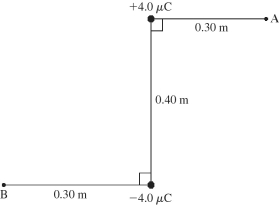
A) +264 mJ
B) -264 mJ
C) 0.00 J
D) -26.4 mJ
E) +26.4 mJ
Correct Answer

verified
Correct Answer
verified
Multiple Choice
Two point charges,Q1 and Q2,are separated by a distance R.If the magnitudes of both charges are doubled and their separation is also doubled,what happens to the electrical force that each charge exerts on the other one?
A) It increases by a factor of 2.
B) It increases by a factor of
C) It is reduced by a factor of
D) It increases by a factor of 4.
E) It remains the same.
Correct Answer

verified
Correct Answer
verified
Multiple Choice
Two tiny grains of sand having charges of 4.0 μC and -4.0 μC are situated along the x-axis at x1 = 2.0 m and x2 = -2.0 m.What is electric potential energy of the system of these grains assuming that at infinity the energy of the system is zero? (k = 1/4πε0 = 9.0 × 109 N ∙ m2/C2)
A) -36 mJ
B) 36 mJ
C) 0 J
D) -72 mJ
E) 72 mJ
Correct Answer

verified
Correct Answer
verified
Multiple Choice
The figure shows a group of three particles,all of which have charge Q = 8.8 nC.How much work did it take to assemble this group of charges if they all started out extremely far from each other? (k = 1/4πε0 = 9.0 × 109 N ∙ m2/C2) 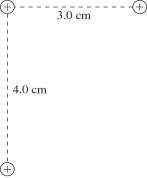
A) 5.5 × 10-5 J
B) 6.2 × 10-5 J
C) 5.7 × 10-5 J
D) 5.9 × 10-5 J
Correct Answer

verified
Correct Answer
verified
Multiple Choice
Suppose you wanted to hold up an electron against the gravitational force by the attraction of a fixed proton some distance above it.How far above the electron would the proton have to be? (k = 1/4πε0 = 9.0 × 109 N ∙ m2/C2,e = 1.6 × 10-19 C,mproton = 1.67 × 10-27 kg,melectron = 9.11 × 10-31 kg)
A) 1.5 m
B) 2.3 m
C) 3.7 m
D) 4.6 m
E) 5.1 m
Correct Answer

verified
Correct Answer
verified
Multiple Choice
A hydrogen nucleus,which has a charge +e,is situated to the left of a carbon nucleus,which has a charge +6e.Which statement is true?
A) The electrical force exerted on the hydrogen nucleus is to the left, and the magnitude is equal to the force exerted on the carbon nucleus.
B) The electrical force exerted on by the hydrogen nucleus is to the left, and the magnitude is greater than the force exerted on the carbon nucleus.
C) The electrical force exerted on by the hydrogen nucleus is to the left, and the magnitude is less than the force exerted on the carbon nucleus.
D) The electrical force exerted on by the hydrogen nucleus is to the right, and the magnitude is equal to the force exerted on the carbon nucleus.
Correct Answer

verified
Correct Answer
verified
Multiple Choice
A hydrogen atom consists of a proton and an electron.If the orbital radius of the electron increases,the electric potential energy of the electron-proton system
A) increases.
B) decreases.
C) remains the same.
D) depends on the zero point of the potential.
Correct Answer

verified
Correct Answer
verified
Multiple Choice
An electron is released from rest at a distance of 9.00 cm from a fixed proton.How fast will the electron be moving when it is 3.00 cm from the proton? (k = 1/4πε0 = 8.99 × 109 N ∙ m2/C2,e = 1.60 × 10-19 C,melectron = 9.11 × 10-31 kg,mproton = 1.67 × 10-27 kg)
A) 75.0 m/s
B) 106 m/s
C) 130 m/s
D) 1.06 × 103 m/s
E) 4.64 × 105 m/s
Correct Answer

verified
Correct Answer
verified
Multiple Choice
Two very small plastic balls of equal mass are released from rest.One of them carries +10 µC of excess charge and the other one carries +1µC of charge.No other charges or fields are present.Which of the following statements are true about them as they move away from each other? (There may be more than one correct choice.)
A) The acceleration of the 10-µC ball is 10 times that of the 1-µC ball.
B) The acceleration of the 1-µC ball is 10 times that of the 10-µC ball.
C) The balls always have accelerations of equal magnitude.
D) The speed of the balls keeps increasing.
E) The acceleration of the balls keeps increasing.
Correct Answer

verified
Correct Answer
verified
Multiple Choice
As shown in the figure,three charges are at the vertices of an equilateral triangle.The charge Q is 6.7 nC,and all the other quantities are accurate to two significant figures.What is the magnitude of the net electric force exerted on the charge Q by the other two charges? (k = 1/4πε0 = 9.0 × 109 N ∙ m2/C2) 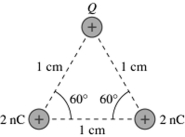
A) 2.1 × 10-3 N
B) 1.2 × 10-3 N
C) 1.0 × 10-3 N
D) 1.4 × 10-3 N
Correct Answer

verified
Correct Answer
verified
Multiple Choice
Two uncharged metal spheres,#1 and #2,are mounted on insulating support rods.A third metal sphere,carrying a positive charge,is then placed near #2.Now a copper wire is momentarily connected between #1 and #2 and then removed.Finally,sphere #3 is removed.In this final state
A) spheres #1 and #2 are still uncharged.
B) sphere #1 carries positive charge and #2 carries negative charge.
C) sphere #1 carries negative charge and #2 carries positive charge.
D) spheres #1 and #2 both carry positive charge.
E) spheres #1 and #2 both carry negative charge.
Correct Answer

verified
Correct Answer
verified
Multiple Choice
A +3.0-µC point charge is initially extremely far from a positive point charge Q.You find that it takes 41 J of work to bring the +3.0-µC charge to the point x = 3.0 mm,y = 0.0 mm and the point charge Q to the point x = -3.0 mm,y = 0.00 mm.What is Q? (k = …)
A) 55 nC
B) 9.1 µC
C) 4.6 µC
D) 27 pC
Correct Answer

verified
Correct Answer
verified
Multiple Choice
Four point charges of varying magnitude and sign are arranged on the corners of the square of side d as shown in the figure.Which one of the arrows shown represents the sum of the forces exerted on the point charge with a charge +Q? 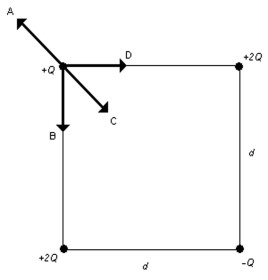
A) A
B) B
C) C
D) D
Correct Answer

verified
Correct Answer
verified
Multiple Choice
A proton is located at the point (x = 1.0 nm,y = 0.0 nm) and an electron is located at the point Find the magnitude of the electrostatic force that each one exerts on the other.(k = 1/4πε0 = 9.0 × 109 N ∙ m2/C2,e = 1.6 × 10-19 C)
A) 1.4 × 10-11 N
B) 5.3 × 10-18 N
C) 5.3 × 108 N
D) 5.9 × 10-15 N
Correct Answer

verified
Correct Answer
verified
Multiple Choice
A small 4.0-µC charge and a small 1.5-µC charge are initially very far apart.How much work does it take to bring them to a final configuration in which the 4.0-µC charge is at the point x = 1.0 mm,y = 1.0 mm,and the 1.5-µC charge is at the point x = 1.0 mm,y = 3.0 mm? (k = 1/4πε0 = 8.99 × 109 N ∙ m2/C2)
A) 27 J
B) 13.5 kJ
C) 54 J
D) 13.5 J
Correct Answer

verified
Correct Answer
verified
Multiple Choice
The figure shows two tiny 5.0-g spheres suspended from very light 1.0-m-long threads.The spheres repel each other after each one is given the same positive charge and hang at rest when θ = 4.1°.What is the charge on each sphere? (k = 1/4πε0 = 9.0 × 109 N ∙ m2/C2) 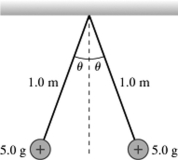
A) 22 nC
B) 89 nC
C) 360 nC
D) 180 nC
E) 45 nC
Correct Answer

verified
Correct Answer
verified
Multiple Choice
An electron and a proton are released simultaneously from rest and start moving toward each other due to their electrostatic attraction,with no other forces present.Which of the following statements are true just before they are about to collide? (There could be more than one correct choice.)
A) They are closer to the to the initial position of the electron that to the initial position of the proton.
B) They are closer to the to the initial position of the proton that to the initial position of the electron.
C) They are at the midpoint of their initial separation.
D) They both have the same speed.
E) The electrostatic force exerted on the proton is greater than the electrostatic force exerted on the electron.
Correct Answer

verified
Correct Answer
verified
Showing 61 - 78 of 78
Related Exams